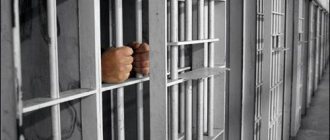Criminal procedural acts
One of the manifestations of the procedural form is the rule that all procedural actions and decisions made should be recorded in writing in certain acts - procedural documents.
The law establishes a form for these acts that makes it possible to fully reflect in them the progress and results of investigative and judicial actions, the decisions made, and subsequently use the data obtained in the investigation, consideration, resolution of a criminal case and checking the legality and validity of the actions taken and decisions made . Without procedural documents provided for by law, there is no criminal process, no case, and therefore, no essence.
A procedural act should be considered as a complex entity, representing the unity of a decision, actions and a procedural document.
A criminal procedural act can be defined as the act of applying the rules of law,
- generating, changing or terminating criminal procedural relations, as well as
- confirming the presence or establishing the absence of material legal relations and
- characterized by the implementation of certain activities, which are implemented in the form established by law through appropriate decisions and actions reflected in procedural documents.
Groups of procedural acts:
- protocols of investigative and judicial actions, which certify the fact of production, content and results of investigative and judicial actions (inspection protocol, interrogation protocol, court hearing protocol);
- decisions (law enforcement acts containing answers to legal questions arising during the proceedings, and authoritative instructions on legal actions).
Decisions can be expressed in the form of a resolution, determination, verdict, sentence. They differ in the bodies, persons receiving them, in the range of issues, in the procedural order of their adoption and in the form of presentation.
Procedural decisions as acts of application of criminal procedural law and criminal law are characterized by a number of features:
- decisions are made only by authorized state bodies, officials, jurors within the limits of their competence;
- express an authoritative command, confirm, change or terminate criminal procedural relations, confirm the presence or establish the absence of material legal relations;
- are adopted in accordance with the established procedure and are expressed in the form specified by law.
0
1
List of questions for the exam
- The concept of criminal process and its purpose.
- Sources of criminal proceedings.
- Forms (types) of criminal proceedings.
- Criminal procedural law. Criminal procedural relations...
- Criminal procedural form and procedural guarantees.
- Stages of the criminal process. A brief description of.
- The concept and system of principles of criminal procedure.
- The principle of legality in criminal proceedings. Administration of justice only by the court.
- The principle of respect for honor and dignity. The principle of personal integrity.
- The principle of protecting the rights and freedoms of man and citizen in criminal proceedings. Inviolability of the home. Secrecy of correspondence, telephone and other conversations, postal and other messages.
- Freedom to evaluate evidence. The right to appeal procedural actions and decisions.
- The language in which legal proceedings are conducted.
- The principle of ensuring the suspect and accused the right to defense.
- Presumption of innocence.
- Competitiveness of the parties.
- Concept and classification of subjects of criminal proceedings. Criminal procedural functions
- Grounds for refusal to initiate a criminal case, termination of a criminal case and criminal prosecution.
- Court in criminal proceedings.
- Procedural position of the suspect.
- The procedural position of the accused in criminal proceedings.
- Defense attorney in criminal proceedings.
- Inquiry body. Interrogator.
- Victim in criminal proceedings.
- Civil plaintiff and civil defendant, their procedural position.
- Prosecutor in criminal proceedings.
- Head of the investigative agency.
- Investigator in criminal proceedings (powers of the investigator, his procedural independence).
- Criminal prosecution. Termination of criminal prosecution.
- Other participants in legal proceedings.
- Subject and limits of proof..
- The concept of evidence, its properties.
- Classification of evidence, its meaning.
- Process of proof. The structure of the evidentiary process.
- The essence and methods of collecting evidence.
- Verification and evaluation of evidence.
- The burden of proof in criminal proceedings.
- Rules for classifying evidence as inadmissible.
- Evidence.
- Protocols of investigative actions and court hearings as evidence.
- Measures of procedural coercion.
- Detention of the suspect.
- Preventive measures (concept, types, grounds and procedure for their election, cancellation and modification).
- Detention as a preventive measure.
- Preventive measures not related to detention.
- Other measures of procedural coercion.
- Procedural deadlines and costs.
- Petitions and complaints.
- Rehabilitation.
- Reasons and grounds for initiating a criminal case.
- The procedure for initiating and refusing to initiate a criminal case.
- General conditions of preliminary investigation.
- Jurisdiction
- General conditions of preliminary investigation.
- Concept and system of investigative actions.
- Inspection, examination, investigative experiment.
- Search, seizure, seizure of postal and telegraphic items, control and recording of negotiations.
- Interrogation, confrontation, identification, verification of testimony.
- Production of forensic examination.
- Involvement as an accused. Arraignment.
- Suspension and resumption of preliminary investigation (concept, grounds, procedure).
- Termination of a criminal case during the preliminary investigation.
- The end of the preliminary investigation with the referral of the case to court.
- Supervision of the prosecutor over the implementation of laws by the bodies of inquiry and preliminary investigation.
- Actions and decisions of the prosecutor in a case received with an indictment.
- Closing indictment. Indictment (essence, meaning, structure).
- Inquiry.
- Preparing for the court hearing.
- The powers of a judge in a criminal case brought to court.
- Preliminary hearing.
- Decisions made by the court in preparation for the trial.
- Jurisdiction and its types.
- The concept and meaning of the general conditions of trial.
- Concept and structure of judicial proceedings.
- Preparatory part of the court session.
- Judicial investigation.
- Judicial debate. The last word of the defendant.
- A verdict is an act of justice. Legality, validity, motivation and fairness of the sentence. Sentence structure.
- Sentencing procedure. Issues resolved by the court when rendering a sentence.
- Conviction.
- Grounds for the acquittal.
- A special procedure for making a court decision if the accused agrees with the charge brought against him.
- Proceedings in criminal cases under the jurisdiction of a magistrate.
- Features of judicial investigation in a jury trial.
- The procedure for reaching a verdict and sentence in a jury trial.
- Appealing court decisions that have not entered into legal force.
- Appeal procedure for consideration of a criminal case.
- Main features of cassation.
- Grounds for canceling or changing a decision in cassation.
- Limits of the rights of the appellate and cassation instances.
- The procedure for applying for the execution of sentences, rulings and decisions.
- Proceedings to consider and resolve issues related to the execution of a sentence.
- The essence of supervisory proceedings.
- Grounds for canceling or changing a court decision in a supervisory authority. Limits of the rights of the supervisory authority.
- Resumption of criminal proceedings due to new or newly discovered circumstances (grounds, procedure, terms).
- Peculiarities of proceedings in cases of minors.
- Proceedings for the application of compulsory medical measures.
- Peculiarities of criminal proceedings in relation to certain categories of persons.
- Interaction with foreign states and international organizations in the field of criminal proceedings.
- Extradition of a person for criminal prosecution or execution of a sentence and transfer of the person to serve the sentence to the state of which he is a citizen.
Chapter 1. PROCEDURAL ACTS IN CRIMINAL PROCEEDINGS
Document's name
“Procedural (judicial) acts in criminal proceedings: Textbook”
(Zagorsky G.I., Kachalov V.I.)
(“RAP”, 2014)
date
28.04.2014
Publication information
Zagorsky G.I., Kachalov V.I. Procedural (judicial) acts in criminal proceedings: a textbook. M.: RAP, 2014. 192 p.
Document Note
Document text
FEDERAL STATE BUDGET EDUCATIONAL
INSTITUTION OF HIGHER PROFESSIONAL EDUCATION
RUSSIAN ACADEMY OF JUSTICE
PROCEDURAL (JUDICIAL) ACTS IN CRIMINAL PROCEEDINGS
TUTORIAL
G.I. ZAGORSKY, V.I. KACHALOV
Authors:
Zagorsky G.I., Professor of the Department of Criminal Procedure Law, Criminalistics and Forensic Science named after N.V. Radutnaya Russian Academy of Justice, Doctor of Law. Sciences, Professor, Honored Lawyer of the RSFSR, Honored Scientist of the Russian Federation, Academician of the Russian Academy of Natural Sciences;
Kachalov V.I., Professor of the Department of Criminal Procedure Law, Criminalistics and Forensic Science named after N.V. Radutnaya Russian Academy of Justice, Ph.D. legal Sciences, Associate Professor.
Reviewers:
Slobodanyuk I.A., Head of the Department of Criminal Procedure of the Military University of the Ministry of Defense of the Russian Federation, Ph.D. legal Sciences, Associate Professor;
Mamykin A.S., Deputy Head of the Department of Organization of Judicial and Law Enforcement Activities of the Russian Academy of Justice, Ph.D. legal Sciences, Associate Professor, Honored Lawyer of the Russian Federation.
INTRODUCTION
During criminal proceedings, at all stages of the process without exception, the investigator, the head of the unit of the inquiry body, the investigator, the head of the investigative body, the prosecutor, the judge and the court are obliged, in cases provided for by criminal procedure legislation, to make procedural decisions that record the results of their activities in accordance with the law. resolution of a criminal case, consideration of complaints and petitions filed by participants in the process, ensuring the rights and legitimate interests of persons participating in criminal proceedings.
These decisions are reflected in written procedural acts, to which the law imposes certain requirements regarding their content and form.
The basis for drawing up procedural documents that meet all the requirements of the law is, first of all, knowledge of the norms of criminal procedure law, mastering certain skills in their practical application when performing the duties of an interrogator, investigator, head of an investigative body, prosecutor, lawyer, judge.
This manual is intended to help students deepen and expand the knowledge they have acquired when studying courses in criminal procedural law, prosecutorial supervision, the fundamentals of advocacy, organization of court activities and other academic disciplines, to gain an understanding of the types of judicial acts in criminal proceedings, their classification, the grounds for their renderings in accordance with the circumstances established in the criminal case, to understand the requirements of the criminal procedure law for their content and form.
The textbook is intended, first of all, for students studying the special course “Procedural (judicial) acts in criminal proceedings” and is intended to provide them with the necessary assistance in mastering criminal procedural norms that regulate the types and grounds for issuing judicial acts in a criminal case, defining general requirements, requirements for them, as well as requirements relating to their content and form. At the same time, the textbook is designed to instill in students initial practical skills in drawing up judicial acts issued by courts and judges at various stages of the criminal process. To a certain extent, the manual can also be used by practical workers: judges, prosecutors, lawyers, investigators, interrogators when they perform functional duties in criminal proceedings.
In accordance with this plan, in Chap. 1 the theoretical provisions are considered: the concept, types and classification of procedural, including judicial acts in a criminal case, the requirements of the criminal procedural law for them are determined, general recommendations are given on the methodology for drawing up judicial procedural acts, as well as recommendations regarding language and style procedural acts.
In ch. 2 reveals the concept, types and essence of procedural acts that are drawn up during criminal proceedings in accordance with the requirements of the current Code of Criminal Procedure of the Russian Federation at various stages of the pre-trial part of criminal proceedings.
In ch. Chapter 3 analyzes judicial acts that are issued in accordance with the requirements of the current Code of Criminal Procedure of the Russian Federation at various stages of the judicial part of criminal proceedings.
In preparing the manual, the authors used theoretical works on the issues under consideration, as well as personal experience of practical work in judicial and law enforcement agencies.
Chapter 1. PROCEDURAL ACTS IN CRIMINAL PROCEEDINGS
1.1. Concept, types and classification of procedural acts
in a criminal case and the requirements imposed on them
Procedural acts in criminal proceedings are legal documents that are drawn up by officials specified in the law on the grounds and in the manner provided for by the Criminal Procedure Code in compliance with the requirements for their content and form in order to confirm the rights and obligations of persons participating in a criminal case or establish legal facts, events or actions entailing legal consequences <1>.
———————————
<1> See: Tikhomirov Yu.A., Kotelevskaya I.V. Legal acts. M., 1995. P. 7; Procedural and official documents of the investigator. M., 2005; Course of criminal proceedings: textbook: 3 volumes / coll. auto; edited by V.A. Mikhailova. Voronezh: Modek, 2006. T. 1. P. 791 - 797.
The term " document " comes from the Latin word documentum, which means "instructive example, way of proving". For the first time in Russia, this word appeared under Peter I. It was used to describe business papers that had legal significance. Currently, documents are understood as written acts, business papers, certificates that are evidence or confirmation of any right or any fact.
There is a close connection between procedural acts-decisions and acts-protocols drawn up in a criminal case, since decisions can be made by the investigator, the inquiry officer, the inquiry body and the court on the basis of evidence recorded in the prescribed manner in the relevant protocols of investigative actions. The preparation of a protocol is usually carried out during an investigative action, which is sometimes carried out only on the basis of a decision of the investigator, inquiry officer, inquiry body (for example, seizure) and court (for example, search).
A procedural act (document) is a means by which information about facts, events, phenomena of objective reality and the mental activity of participants in criminal proceedings during criminal proceedings is fixed in various ways on special material <1>.
———————————
<1> See: Criminal procedure of the Russian Federation: Textbook / ed. prof. A.P. Kruglikova. M.: Prospekt, 2010. P. 301 - 304.
In procedural acts (documents), the necessary information can be recorded in various ways: handwritten, typewritten, typographical, as well as using drawings, graphic images, drawings, etc.
The preparation of procedural acts with the recording in them of the information necessary for the correct resolution of a criminal case is called documentation .
In criminal proceedings, documentation is carried out in compliance with the established forms of procedural documents.
A procedural act as a procedural document in which a procedural action is fixed.
A procedural action and a procedural document have the same relationship as essence and phenomenon, as content and form.
The form of a procedural document is a necessary set of elements for its correct execution and presentation of content.
The elements of document registration include : name of the act, mailing and shipping address, date, registration number, stamp, etc.
The elements of document content include structural parts of the main text: introductory, descriptive and motivational, operative parts, as well as applications, diagrams, etc. The form of a procedural document is determined by law depending on its purpose and content.
A procedural document as a written act emanating from the relevant participants in criminal proceedings authorized to carry out criminal procedural activities in a criminal case <1>.
———————————
<1> See: Criminal procedure: textbook / ed. V.P. Bozhyova. 3rd ed. M.: Spartak, 2002. P. 265 - 275.
A procedural document is drawn up on the basis of the activities of the investigator, inquiry officer, inquiry agency, prosecutor and court during the investigation of crimes, during the trial of a criminal case or review of a court decision in a criminal case, during the execution of court decisions in accordance with the criminal procedure law. It contains a specific decision on a specific criminal case or reflects the progress and result of investigative and judicial actions.
Procedural acts (documents) are the main sources and carriers of information about the circumstances of the crime committed, established in a criminal case.
Procedural documents can be classified: by name; in the area of activity of the official; at the place of their compilation; by form; by the nature of the issues resolved in them; according to the degree of authenticity and publicity of documents; on other grounds.
By name , there are several types of procedural documents. These include: a resolution to initiate a criminal case, an indictment, an indictment, an indictment, a sentence, etc. All types of procedural documents are characterized by requisites.
The type of document as a set of documents that have a common purpose, mandatory and uniform details.
Props are a mandatory element that is inherent in a certain type of procedural document.
In accordance with procedural law, a document cannot be used as evidence in a criminal case if it lacks at least one of the mandatory elements provided for by law for a given procedural act (for example, there is no indication of the author of this document, there is no corresponding signature, etc. .P.).
In this regard, a very typical example from judicial practice is the cassation ruling of the St. Petersburg City Court in a criminal case.
Having recognized the absence of an indication that the verdict was passed in the name of the Russian Federation, a significant violation of the criminal procedural law, entailing the cancellation of the district court's verdict with the referral of the criminal case to the court of first instance for a new trial in a different composition of the court, the judicial panel indicated that the court of first instance violated the constitutional provision that the verdict is passed in the name of the state. The absence of such an indication in the sentence, in the opinion of the cassation court, is a significant violation of the criminal procedure law, entailing its cancellation, since the absence of such an indication in the text of the sentence, in essence, makes the court's sentence legally void.
In general office work, there is also such a concept as a form, which is understood as a set of document details arranged in a prescribed sequence.
According to the direction (nature) of the activities of officials, procedural documents are divided:
- on acts of preliminary investigation,
— acts of prosecutorial supervision;
— judicial acts;
— acts of lawyers;
- other participants in the criminal process.
Based on the place of preparation , a distinction is made between internal (intra-institutional) and external procedural documents. Internal documents are drawn up by the investigator, the inquiry officer, officials of the inquiry body, the head of the investigative body, the judge and are used in criminal proceedings. External documents can be outgoing or incoming. With the help of external documents, communication between the inquiry body, the inquiry officer, the investigator and the court is ensured with other government bodies, public organizations and individual citizens. Outgoing documents are those that are sent by the investigator, officials of the inquiry agency, the interrogating officer, the court to other bodies and institutions, incoming documents are those that come from other institutions, organizations, from officials or citizens.
According to their form, documents are divided into: individual, standard and stencil. Individual documents are drawn up in any form; standard - based on the model provided for by law. In stencil documents, a certain part of the document is printed in advance, and the rest is filled in when drawing up procedural acts.
Based on the number of questions reflected in the document, they are divided into simple and complex. Simple documents address one issue, while complex address several different issues.
the degree of authenticity, procedural documents are divided into draft documents (draft), originals and copies. A draft (draft) of a procedural act is a document in a preliminary, original version. The original is the final version of the document, duly drawn up and signed by an authorized official. A copy is a document that reproduces all the details of the original procedural act (document).
According to the degree of publicity, procedural documents are divided into secret and unclassified; by deadlines - urgent and non-urgent; by storage period - for documents of permanent and temporary storage.
Each procedural act consists of several parts containing mandatory elements provided for in the criminal procedure law. The presence of mandatory elements (details) in each specific document is determined by the purpose of the procedural act and its content.
For example, in accordance with the criminal procedural law, the most common procedural act - the investigative protocol - must contain the following details:
1. Name of the protocol.
2. Place and date of the investigative action.
3. Its start and end time accurate to the minute.
4. Position and surname and initials of the person who compiled the protocol.
5. Last name, first name and patronymic of each person participating in the investigative action, and, if necessary, his address and other information about his personality.
Other elements reflected in Art. 166 Code of Criminal Procedure of the Russian Federation.
The content and form of procedural documents used in criminal proceedings are determined in the norms of the criminal procedure law.
A document in criminal proceedings is a carrier of information about facts, the content and methods of recording of which are given legal significance by the current criminal procedural legislation.
It should be especially emphasized that according to Art. 74 of the Code of Criminal Procedure of the Russian Federation, protocols of investigative and judicial actions are evidence in a criminal case. Thus, the protocols of the inspection of the scene of the incident, the conduct of the investigative experiment, the protocol of identification and other investigative actions carried out during the preliminary investigation are examined during the trial and can serve as the basis for a verdict.
The protocol of the court session, drawn up in strict accordance with the requirements of Art. 259 Code of Criminal Procedure of the Russian Federation, 389.34 Code of Criminal Procedure of the Russian Federation; clause 10 art. 401.13 Code of Criminal Procedure of the Russian Federation; clause 9 art. 412.10 of the Code of Criminal Procedure of the Russian Federation, is evidence when considering a criminal case in a court of appeal and cassation and when re-examining a criminal case in a court of first instance in the event of cancellation of the original verdict.
Procedural documents in criminal proceedings, depending on the powers of the body that draws them up, can be investigative or judicial.
Investigative documents are drawn up by the inquiry officer, the head of the inquiry unit, the investigator, the head of the investigative body, and the prosecutor.
Judicial procedural documents can be drawn up by a judge or court during criminal proceedings at both the pre-trial and trial stages.
Procedural investigative and judicial documents are closely interconnected. A criminal case submitted to a court with an indictment, indictment or indictment is subject to mandatory consideration by the court within the limits of the charges formulated in the specified procedural documents. However, the court is not bound by the conclusions set out in them when making a decision, as well as when assessing the completeness and reliability of the evidence.
Investigative (procedural) documents are the legal basis for judicial activity and the successful resolution of a criminal case by the court.
The concept of criminal procedural acts. Procedural decisions and protocols, their characteristics
These are written acts that record the progress and results of various investigative actions (inspection, presentation for identification, etc.). These include protocols of investigative actions and protocols of court hearings (Article 83 of the Code of Criminal Procedure). During pre-trial proceedings, each investigative action is documented in a separate protocol; during the judicial investigation, all actions carried out by the court are recorded in one document - the protocol of the court session.
The protocols of the following investigative actions for collecting evidence have independent evidentiary value: inspection (including examination of the corpse and exhumation), examination, seizure, search, presentation for identification, investigative experiment and verification of testimony on the spot. These protocols should be distinguished from other protocols, which are also drawn up during the investigation and trial of the case, but are not independent sources of evidence (for example, a protocol of interrogation, confrontation). In these cases, the evidence of the interrogated persons (witnesses, accused, etc.) has evidentiary force, and not the protocol, which acts only as a technical means of recording testimony and does not have independent significance as a source of evidence.
The protocols of other investigative actions do not record evidence, but only reflect the investigator’s fulfillment of certain requirements of the law (for example, the protocol of familiarizing the accused with the materials of the criminal case), and therefore they do not have evidentiary value. When carrying out investigative actions, various scientific and technical means can be used - photography, audio and video recording, drawings, plans, diagrams, casts and prints of traces that are attached to the protocol (Article 166 of the Code of Criminal Procedure).
All these sources of evidentiary information are not named among the individual types of evidence (Article 74 of the Code of Criminal Procedure), therefore they are usually called appendices to the protocols. They can have evidentiary value only if there is a protocol that reflects a specific fact, as well as the conditions for making casts and impressions. However, they not only confirm and illustrate the contents of the protocol, but may also contain additional evidentiary information.
From the point of view of the theory of evidence, the minutes of the hearing of the court of first and appellate instances, in which the criminal case is considered on its merits, are of greatest value. Such protocols reflect from beginning to end all judicial actions and decisions committed or adopted during the trial. It serves as independent evidence (Article 83 of the Code of Criminal Procedure) and as such can be used when reviewing a given criminal case by a higher court, as well as when reconsidering it by a court of first or appellate instance.
Protocols of investigative actions and records of court hearings are admitted as evidence only if they meet the requirements established by law. Therefore, violations of these rules may result in the invalidity - in whole or in part - of the protocol as evidence (for example, the absence of signatures of witnesses or the presentation of an object in the singular for identification).






